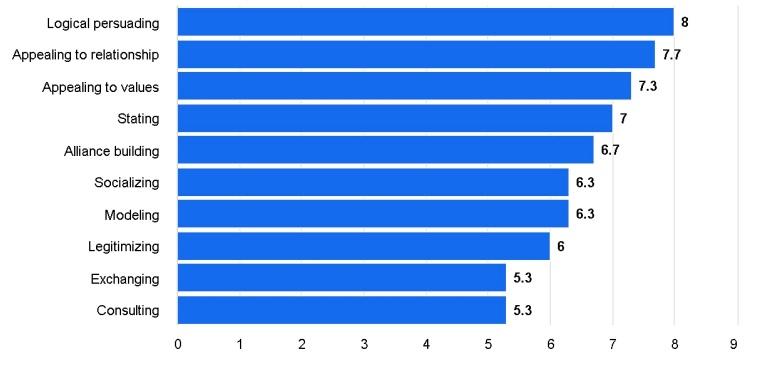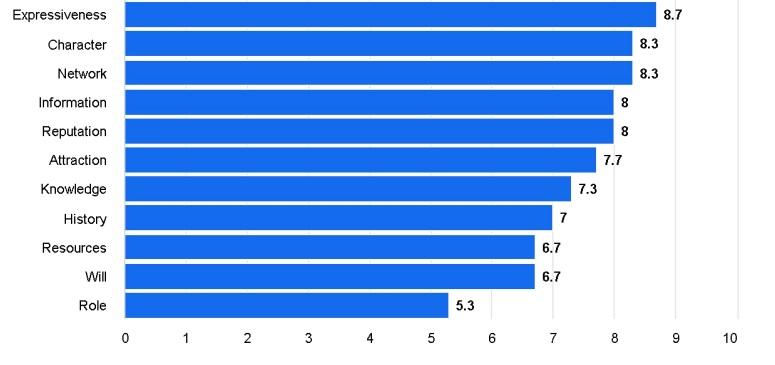Introduction
The success and quality of health care depend on multiple factors, and one of them is the balance between power and influence. According to Barasa et al. (2016), power imbalances provoke additional questions and challenges in understanding care providers’ interests and values in the context of their professional relationships. Therefore, it is not enough just to ensure that some balance between the chosen concepts is achieved. Healthcare professionals should know more about the sources of power and recognize the clusters of influence. Hospital managers must improve their leadership skills and remember that power and influence can bring positive and negative outcomes to the environment. The evaluation of social power bases and the ways how individuals develop their tactics is a goal of this paper. After taking the two self-assessments, I will be able to learn how I should balance power and influence in my progress as a health care professional.
Sources of Power
Power may provoke additional problems if people do not know how to use it properly. Bacon (2010b) admits that the greater power sources are discovered, the better influence on society is. Power is an ability to lead and influence others’ behaviors (Neider & Schriesheim, 2004). There are five major sources of power, namely reward, coercive, legitimate, referent, and expert (Raven, 2004). Reward power is when one individual uses an incentive for another person to comply with a task. Coercive power is similar to reward, with the only difference which is the threat of punishment to force the events (Neider & Schriesheim, 2004; Raven, 2004). Legitimate power is rooted in the ability to affect people relying on the existing rights and obligations like a doctor prescribes drugs to treat a patient’s condition. Referent power depends on the level of attraction in interpersonal relationships. In expert power, leaders and managers address such sources as knowledge and skills. These high qualities help them achieve the best standards in their practice.
Clusters of Upward Influence
Another critical element of professional leadership and management is influence. Bacon (2010a) explains it as the application of power to achieve a goal. In their study, Kipnis and Schmidt (as cited in Boorkowski, 2016) introduce four major clusters of influence with their specific tactics: shotgun, tactician, bystander, and ingratiator. Shotguns are ready to use all available resources and means, demonstrating assertiveness and addressing authority (Boorkowski, 2016). Tacticians prefer to make rational decisions with average use of tactics, while bystanders prefer to reduce the number of tactics, regardless of their purposes and sources. Finally, there are ingratiators whose level of influence is the lowest due to their friendly and supportive intentions.
Results of Assessment
My decision to take several tests helps me assess my qualities and knowledge and learn what techniques and sources define my progress in the healthcare field. As shown in Figure 1 (see Appendix), logical persuading is my strongest quality, while consulting and exchanging are my current weaknesses (Bacon, 2010c). Most techniques, including stating, appealing to values and relationships, socializing, and modeling, are between 6 and 7. My overall rating is 66%, which tells about the necessity to work hard on my leadership qualities. Another self-assessment, Figure 2 (see Appendix), reveals an overall rating of 75%, proving my solid understanding and application of power resources (Bacon, 2010c). While there is a great difference between high expressiveness and low role power, other characteristics and sources like attraction, knowledge, reputation, and information are within the same limits. I was a bit surprised with the results because I expected higher influence ratings, more like those achieved in the power sources assessment. Therefore, I think that my balance between power and influence is not perfect, and I have to work harder for improvement.
Based on my results, I think that expert power is probably one of the best sources to be identified. According to Boorkowski (2016), this power exists between individuals when one’s perception of another’s knowledge is observed. Having superior knowledge in the chosen field is a stable source of power. My strongest influence technique, logical persuading, and power source like expressiveness create a solid background for using information and knowledge to work with people and maintain the balance of power and influence with time. With time, this combination of qualities and resources should work effectively for professional leadership. Talking about upward influence clusters, I believe I am far from a shotgun type, but I may become a good tactician. On the one hand, I am aware of multiple leadership and management tactics and approaches to cooperating with people. On the other hand, I am not going to use all of them at once but appeal to reason and rationality. This rationale is based on the results that reveal my high attraction, information, and knowledge levels.
Conclusion
In general, the findings of this paper play an important role in developing my career as a health care professional. I understand the importance of balancing power and influence, and I want to use my knowledge to strengthen my skills and eliminate my weaknesses. The assessment results are more than promising because I have a solid basis of qualities that can make me a good leader in health care. I know I have much work to do, but my past experiences help me maintain self-improvement. Instead of relying on what has been achieved, I want to try something new to succeed in consulting and exchanging information.
References
Bacon, T. (2010a). How influence works. Power and Influence. Web.
Bacon, T. (2010b). How power works. Power and Influence. Web.
Bacon, T. (2010c). Self assessments. Power and Influence. Web.
Barasa, E. W., Cleary, S., English, M., & Molyneux, S. (2016). The influence of power and actor relations on priority setting and resource allocation practices at the hospital level in Kenya: A case study.BMC Health Services Research, 16(1). Web.
Boorkowski, N. (2016). Organizational behavior in health care (3rd ed.). Jones and Bartlett Learning.
Neider, L. L., & Schriesheim, C. A. (2004). Power: Overview. In G. R. Goethals, G. L. Sorenson, & J. M. Burns (Eds.), Encyclopedia of leadership (pp. 1248-1251). SAGE
Raven, B. H. (2004). Power, six bases. In G. R. Goethals, G. L. Sorenson, & J. M. Burns (Eds.), Encyclopedia of leadership (pp. 1242-1249). SAGE.
Appendix

